|
 Keeping up with the requirements of the Code should be the goal of everyone involved in electrical safety. Here is this month's newsletter with what I feel is an important rule in the 2017 NEC®, complete with graphics and a video. I encourage you to use it as a training resource for your organization, and share it with your colleagues. Keeping up with the requirements of the Code should be the goal of everyone involved in electrical safety. Here is this month's newsletter with what I feel is an important rule in the 2017 NEC®, complete with graphics and a video. I encourage you to use it as a training resource for your organization, and share it with your colleagues.

The content below is extracted from Mike Holt's Understanding the 2017 National Electrical Code®, Volume 2.
Any underlined text denotes a change to the Code for the 2017 NEC.
|
680.26 Equipotential Bonding |
(B) Bonded Parts. The parts of a permanently installed pool listed in (B)(1) through (B)(7) must be bonded together with a solid copper conductor not smaller than 8 AWG with listed pressure connectors, terminal bars, exothermic welding, or other listed means in accordance with 250.8(A). â–¶Figure 680“43 and â–¶Figure 680“44
.jpg)
|
|
Figure 680“43 |
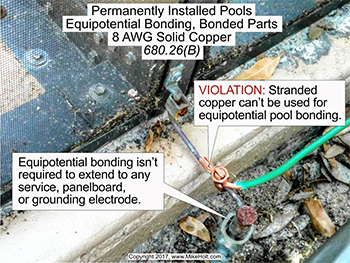
|
|
Figure 680“44 |
|
Equipotential bonding isn't required to extend to or be attached to any panelboard, service equipment, or grounding electrode.
(1) Concrete Pool Shells. Bonding of concrete pool shells must be in accordance with 680.25(B)(1)(a) or (B)(1)(b).
(a) Structural Reinforcing Steel. Unencapsulated (bare) structural reinforcing steel bonded together by steel tie wires or the equivalent. Where structural reinforcing steel is encapsulated in a nonconductive compound, a copper conductor grid must be installed in accordance with 680.26(B)(1)(b). â–¶Figure 680“45
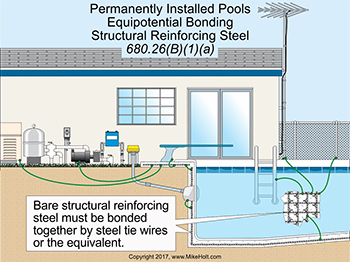
|
|
Figure 680“45 |
(b) Copper Conductor Grid. A copper conductor grid must comply with (b)(1) through (b)(4).
(1) Minimum 8 AWG bare solid copper conductors bonded to each other at all points of crossing in accordance with 250.8 or other approved means.
(2) Conform to the contour of the pool.
(3) Be arranged in a 12-in. by 12-in. network of conductors in a uniformly spaced perpendicular grid pattern with a tolerance of 4 in.
(4) Be secured within or under the pool no more than 6 in. from the outer contour of the pool shell.
(2) Perimeter Surfaces. Equipotential bonding must extend a minimum of 3 ft horizontally beyond the inside walls of a pool, where not separated from the pool by a permanent wall or building of 5 ft in height. â–¶Figure 680“46 and â–¶Figure 680“47
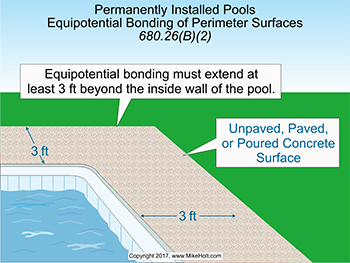
|
|
Figure 680“46 |
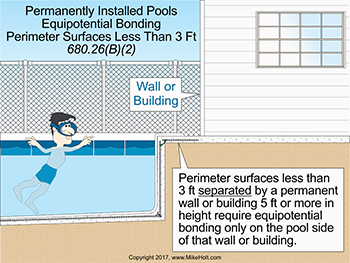
|
|
Figure 680“47 |
|
Bonding of perimeter surfaces must be in accordance with 680.26(B) (2)(a) or (2)(b) and be attached to the concrete pool reinforcing steel or copper conductor grid at a minimum of four (4) points uniformly spaced around the perimeter of the pool. â–¶Figure 680“48
(a) Structural Reinforcing Steel. Structural reinforcing steel bonded together by steel tie wires or the equivalent in accordance with 680.26(B)(1)(a).â–¶Figure 680“49
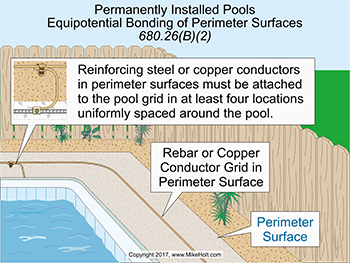
|
|
Figure 680“48 |
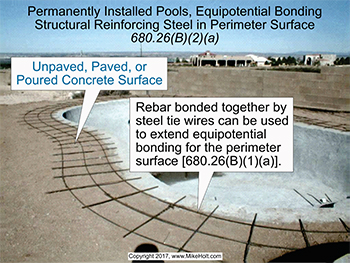
|
|
Figure 680“49 |
|
| Author's Comment: |
-
The NEC doesn't provide any guidance on the installation requirements for structural reinforcing steel when used as a perimeter equipotential bonding method.â–¶Figure 680“50
|
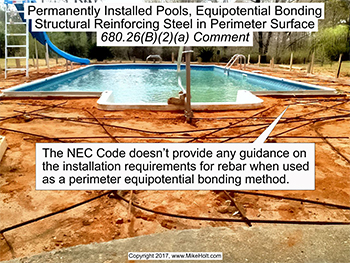
|
|
Figure 680“50 |
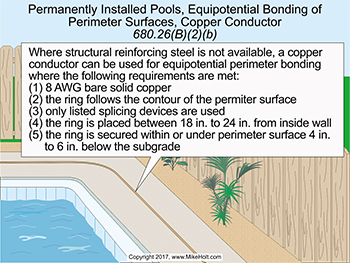
|
|
Figure 680“51 |
|
(b) Alternative Means. Where structural reinforcing steel isn't available (or is encapsulated in a nonconductive compound such as epoxy), equipotential bonding meeting all of the following requirements must be installed: â–¶Figure 680“51
(1) The bonding conductor must be 8 AWG bare solid copper.
(2) The bonding conductor must follow the contour of the perimeter
surface.
(3) Listed splicing devices must be used.
(4) The required conductor must be located between 18 in. and 24 in. from the inside walls of the pool.
(5) The bonding conductor must be secured in or under the deck or unpaved surface within 4 in. to 6 in. below the subgrade.
(3) Metallic Components. Metallic parts of the pool structure must be bonded to the equipotential grid.
(4) Underwater Metal Forming Shells. Metal forming shells must be bonded to the equipotential grid. â–¶Figure 680“52
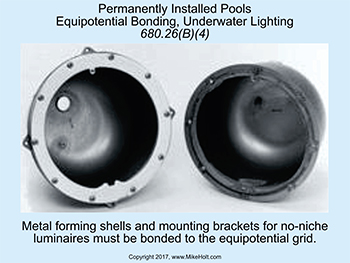
|
|
Figure 680“52 |
(5) Metal Fittings. Metal fittings 4 in. and larger located within or attached to the pool structure, such as ladders and handrails, must be bonded to the equipotential grid. â–¶Figure 680“53
(6) Electrical Equipment. Metal parts of electrical equipment associated with the pool water circulating system, such as water heaters, pump motors, and metal parts of pool covers must be bonded to the equipotential grid. â–¶Figure 680“54
Ex: Metal parts of listed double-insulated equipment aren't required
to be bonded.
(a) Double-Insulated Water-Pump Motors. If a double-insulated water-pump motor is installed, a solid 8 AWG copper bonding conductor must be provided for a replacement motor. |
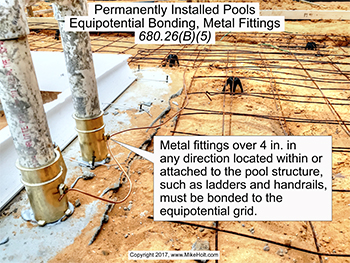
|
|
Figure 680“53 |
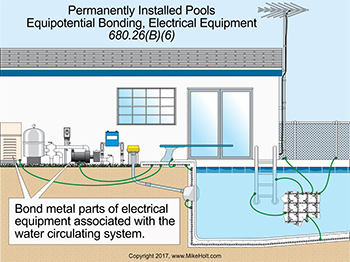
|
|
Figure 680“54 |
|
(7) Fixed Metal Parts. Fixed metal parts must be bonded to the equipotential grid, including but not limited to, metal-sheathed cables and raceways, metal piping, metal awnings, metal fences, and metal door and window frames. â–¶Figure 680“55
Ex 1: If separated from the pool structure by a permanent barrier that prevents contact by a person.
Ex 2: If located more than 5 ft horizontally from the inside walls of the pool structure. â–¶Figure 680“56
Ex 3: If located more than 12 ft measured vertically above the maximum water level.
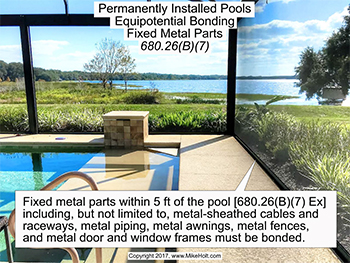
|
|
Figure 680“55 |
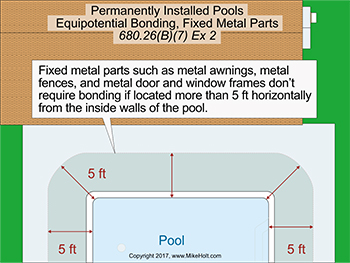
|
|
Figure 680“56 |
|
We'd love to hear from you about this series, and the ways you're using it. Send us your comments and feedback by clicking on Post a Comment below. Look out for the next part in this series a month from now, and please share with your colleagues.
This content is extracted from Mike Holt's Illustrated Guide to Understanding the 2017 National Electrical Code, Volume 2 textbook.
To review or catch up on previous newsletters on the National Electrical Code click here.
 |
Learn More
Understanding the NEC Complete Library
(3 books | 12 DVDs)
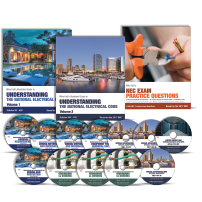

For further information about this or other products please call us at 888.632.2633
We look forward to helping you
|

|
|
|

